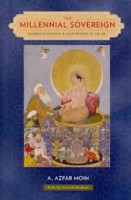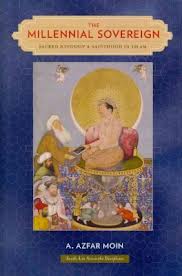 Author: A. Azfar Moin
Author: A. Azfar Moin
Publisher: Columbia University Press – 343 pages
Book Review by: Deekay Daulat
A study of ‘sacred kingship’ (a term the author uses that is new to me) and sainthood in Islam during the Mughal (aka Mogul) period in India (1526-1857) and the Safavid era in Central Asia (1501-1722) is the focus of this one-of-a-kind book.
Why one-of-a-kind? It takes a combined look into kingship (the king as a messiah of God was considered sacred in those millennia) and sainthood, something I have not found in any other book. It offers a new perspective on the Muslim rulers, particularly on how they demonstrated their power and sovereignty while at the same time expressing their sacrality like the Sufi saints did.
I learned in history classes in grade school that the seven Mughal emperors were held in awe, high respect and even fear by their subjects for the vast, almost absolute power they wielded over the people they ruled.
I also learned that at the same time, they were revered by their subjects for being representatives of God, for the great wisdom they possessed, and for the ability to make the right decisions on moral issues, e.g. in matters of right or wrong.
I did not learn much about the Safavids, or at least I do not recall what we went through when we studied them. A map in this book on the left of the Introduction page shows the geographical extent of their rule, and it is truly vast. Their control covered the areas from northwest Europe next to the Caspian Sea through Iran, Iraq and other countries to all the way east of the Kandahar area in Afghanistan.
The coverage of the Mughal Empire meanwhile started from Afghanistan where the Safavid control ended and it stretched all the way east through northern India to the Bay of Bengal next to Kolkata, including north central India.
Here is how A. Azfar Moin characterizes ‘sacred kingship’ during the Safavid and Mughal millennia of sovereign rulers: “The early and foundational monarchs of these two lineages modeled their courts on the pattern of Sufi orders and fashioned themselves as the promised messiah. In their classical phases, both the Mughals and the Safavids embraced a style of sovereignty that was “saintly” and “messianic.”
He continues: “…there developed in this period an ensemble of rituals and knowledge to make the body of the king sacred and to cast it in the mold of a prophesied savior, a figure who would set right the unbearable order of things and inaugurate a new era of peace and justice – the new millennium. Under-girded by messianic conceptions and rationalized by political astrology, this style of sovereignty attempted to bind courtiers and soldiers to the monarch as both spiritual guide and material lord.”
The third Mughal Emperor Akbar (1556-1605) was one of the most powerful. At the height of his powerful regime, he was also most revered in a spiritual sense. As a matter of fact his critics accused him of abandoning Islam and beginning his own ‘sacred dispensation’ as the author describes it.
The author writes that Akbar’s long-lasting empire in South Asia was not only of ‘unrivaled grandeur’ in a material sense, but also, on the spiritual side of life, he asked all his subjects to enroll as ‘disciples’ in a ‘devotional order’ he himself created. He “fashioned himself as the spiritual guide of all his subjects regardless of caste and creed,” Moin asserts.
The decline of the Mughal period in India began in the early eighteenth century during the time of the last ruler Aurangzeb, son of Shah Jahan, builder of the Taj Mahal. But the ‘institutional shell’ of Mughal sovereignty survived for more than a century after its end. Even through periods of weakening of the power of the Mughal dynast through invasions by different forces, he still remained as the sole exclusive symbol of sovereignty in India, until the British came and slowly took away his authority and rule over the country.







